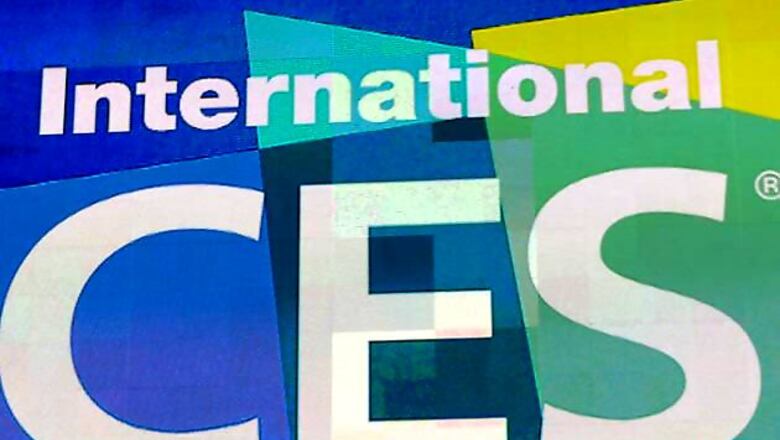
views
Las Vegas: From the world's first eye-controlled laptop and a pet-tracking app to a glass-encased ultra-thin notebook, 2012's Consumer Electronics Show produced more than a few gems to point the way forward in technology.
Out of the noise and confusion of the sprawling electronic circus in Las Vegas, two trends stood clear: we will soon interact with devices without thinking about it - or even being aware of it - and everything we do will be connected to the rest of the world.
From Wifi-enabled vacuum cleaners telling you when to change the filter, to Facebook apps in a Mercedes-Benz and Pandora in a refrigerator door, the message from the show was that all electronics will soon be part of a seamless network.
"In 1998 that was very science-fiction," said Joe Ambeaut, a director of product management for phone network Verizon, looking at the Internet vacuum cleaner. "Now that use case feels like it's an inch away. It's not fantasy. It's real."
Ninety per cent of the world's population will be connected to the Internet by 2015, said the CEO of mobile telecom company Ericsson, who spoke at the show, and there will be 50 billion connected devices by 2020.
That prospect has changed the nature of the world's biggest tech trade show.
"If you were at CES three or four years ago, it was all about who could build the largest flat-panel TV," said Henry Samueli, co-founder of wireless networking firm Broadcom Corp. "Today, everybody is talking about how I connect up devices, how do I share my media, my movies, my music. It's all about connecting the consumer electronic devices."
Visiting chairman of the Federal Communications Commission, Julius Genachowski, put it succinctly. "If you shut off the Internet, virtually nothing on the CES floor would work."
Eye control
Among the technologies that drummed up the most buzz at the show were the Tobii, on which users play games and scroll around screens by just blinking and glancing; and the "Tagg" app that texts or emails you should your pet wander outside a self-defined area.
Devices from technology mainstays also drew their share of admiring crowds, with Hewlett Packard's all-glass "Specter" in the vanguard of what Intel hopes will be a new generation of super-slim, fully wired and touchscreen laptops to replace the clunkers of yesteryear.
Samsung's 5.3-inch screen "phablet" - the Galaxy Note phone-cum-tablet - also drew debate about whether there is room for a miniature tablet to compete with the 11-inch Apple Inc iPad.
More advances were heralded at the show. Chipmaker Intel Corp announced it would team up with Nuance to build voice-command capabilities into its new laptops starting this year. Microsoft Corp promised that a commercial application of its Kinect system - which allows you to play Xbox games just by waving your hands and feet - will be available for PCs from next month.
Mobile goes mainstream
To be sure, mobility and connectivity have been consistent themes at CES since Apple's iPhone kickstarted the mobile consumer Web revolution. TV makers from Samsung to LG have touted so-called Smart TVs - Internet-enabled sets that allow you to surf and stream the Web -- for several years in Las Vegas, with limited success.
But with Intel - the cornerstone of PC-based computing, along with Microsoft - jumping feet-first into "ultrabooks," the paradigm of ever-more-portable, instant-on, just-enough-brainpower to run YouTube devices is now emphatically mainstream.
Microsoft made its own move that way at last year's show, when it announced it would develop operating software for ARM chips -- the architecture that competes with Intel's old x86 and now the global standard for mobile processing because of its power-efficiency.
Even old-guard PC-maker Dell Inc is planning its own tablet finally.
Despite the new emphasis on the network, or what has become known as the ecosystem - the place in the cloud where songs, movies, magazines and apps are stored and accessed - it is clear people are still entranced by devices themselves. That interest in the physical and visual experience looks like it will help keep CES relevant and popular.
This year's edition was the biggest on record, with 1.86 million square feet of show space and more than 3,100 exhibitors, edging past the record of 2008.
Even companies that do not exhibit - such as Apple Inc and Amazon.com - sent execs to the show to see what's new. The show is now the prime place for tech people to mingle with partners, potential customers, venture capitalists, startups and the media.
The announcement by Microsoft that it was quitting the show indefinitely did not appear to dent confidence, and the software company's floorspace was snapped up within hours, CES organizers said.
And the show is still exciting, if you can survive the rigors of crossing 50 Times Squares just to get to where the new thing is.
"It's always fun to be at CES. Where else can you find a USB stick that's also a bottle opener?" joked the FCC's Genachowski.



















Comments
0 comment